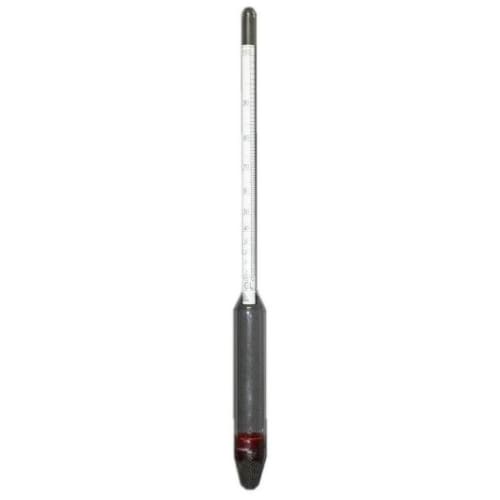distillique
Alcohol Meter: 0-100%
Alcohol Meter: 0-100%
Couldn't load pickup availability
Terms and conditions:
Distillique maintains a policy of non-refund or replacement for items damaged during the shipping process. Each glass item undergoes thorough inspection at our warehouse prior to dispatch. Consequently, Distillique disclaims responsibility in the event that the client receives the item in a damaged condition. Should you wish to have glass items shipped, please be advised that additional packaging charges will be applicable. To accommodate this, kindly add the "packaging fee" for each glass item in your order, as these specialized packaging materials are not incorporated into our standard product pricing. If you have any trouble adding this charge to our order, please send an email to sales@distillique.co.za to amend your invoice.
Opening the alcohol meter container
- Do not pull the two parts of the plastic box apart by using both your hands. The chances of breaking the meter will be very good.
- Rather nudge the outer plastic box slowly with your thumb to prevent any misalignment of the two parts.
Use the right hydrometer for the right job.
- Hydrometers are in effect instruments that measure the density of liquids. Inside each hydrometer is a scale that indicates what the meter reads.
- An SG hydrometer measures the relative density of a liquid compared to that of pure water at a specific temperature. (This temperature is called the calibration temperature.) How to correct reading at other temperatures is shown later.
- SG (Specific Gravity) is an indication how the density of a liquid differs from that of pure water. Pure water measures an SG of 1.000 while an alcohol and water mixture will read below 1.000 (i.e. 0.993) and a sugar/water solution
- A Guy-Lussac hydrometer measures % alcohol by volume and we call it an alcohol meter. An alcohol meter will measure the amount of alcohol (ethanol) mixed with water and give a % alcohol reading.
- Important: An alcohol meter (hydrometer) cannot give a correct reading when we want to measure a liquid that contains alcohol, water AND sugar. The alcohol is less dense than water and the sugar is more dense than water and they sort of cancel each other out with non-applicable readings as a result.
- Many other density related scales are used in various industries such as Degree Brix, Balling, Plato, etc. to give indication of, for example, the weight of sugar dissolved in water (i.e. Brix and Ballin
Handle hydrometers with care - they are fragile instruments.
- Hydrometers are very fragile glass instruments with lead/steel ballast balls at the bottom to allow it to float upright in a liquid. Even a slight bump of glass against glass at the bottom of a hydrometer will crack it and render the hydrometer useless
- .It is important to get into the habit of inserting a hydrometer into a measuring cylinder so that the bottom does not crack.
- Take a measuring cylinder that is suitable to use (big/tall enough but not too big) with the specific hydrometer
- Now tilt the measuring cylinder horizontal and slowly slide the hydrometer into the measuring cylinder until it just touches the bottom of the cylinder.
- Now tilt the cylinder upright and start filling it with liquid until the hydrometer floats.
- A reading can now be taken on the hydrometer at the level of the liquid.
Temperature corrections:
All good hydrometers indicate the temperature at which they are calibrated to give accurate readings. Most hydrometers from Distillique are calibrated at 20 degree C.
If we use a hydrometer in liquid with a temperature other than the calibrated temperature, a correction should be made on the reading. The following table provide (simplified) correction factors to use:

Examples to use this table:
For alcohol and density scaled hydrometers:
Say you measure the % alcohol in a water/alcohol mix which has a temperature of 37 degrees C and the reading on the meter indicates 43%. To correct it we do the following:
Reading(corrected) = Reading(uncorrected) x Correction factor.
= 43 x 0.949 (from the table above at 37 degrees C)
= 40.8
That implies that the correct % alcohol at 37 Degree C is 40.8 %abv.
For density measurements we use it exactly in the same manner.
Other notes on the use of hydrometers:
- If your hydrometer was laying flat and exposed to high temperatures (i.e. in the sun on the dashboard of your car), the wax that keeps the ballast balls in place might have melted and allow the balls to fall around in your hydrometer. To correct this, put the hydrometer vertical and heat again very slowly to allow the wax to melt again and fix the ballast balls.
- Clean your hydrometer with room temperature water and a sterilizer such as Iodophor. NEVER pour boiling water over it to sterilize it. It WILL crack and leave your hydrometer useless.
- Store your hydrometer upright to prevent it from rolling and falling off the table
Share

Thank you. Fast service and well packed.
Speedy service delivery. Very friendly & helpful customer service when you call in. Will definitely purchase from you guys again.
Calibration lines are difficult to see when you get to 60% and lower. For a quick ball park its good.
on the plus side your cylinder or parrot is shorter (less volume) so you have a smaller sample size,
also seems the glass is a bit thicker then the longer one, I haven't manage to crush it with my fingers yet.
Nice and short, you can use a small container for the measurement.

